The Dell Venue 11 Pro 7000 Review
by Brett Howse on April 16, 2015 8:00 AM EST- Posted in
- Tablets
- Dell
- Windows 8.1
- Core M

Back in November, Dell took the lid off of their Venue 11 Pro 7000 refresh which is their first tablet offering to have Core M powering it. Dell is aiming this tablet squarely at the enterprise segment, but with prices that start low enough for consumers to take a look as well. Starting at $699, it is not an inexpensive device, but it does offer some compelling features on top of the powerful (for a tablet) processor. Dell has an entire range of accessories for the tablet to let the end user get the maximum out of the device, and allows the device to be used as a tablet, a laptop, or even a desktop computer.
Dell has leveraged the Intel Core M processor to power this tablet, which gives it quite a bit of a performance boost over most tablets. There are two offerings as well, with the Core M-5Y10c being the base model, and the Core M-5Y71 being the upgrade. Those who opt for the 5Y71 will enjoy the benefits of Intel vPro as well as the peak performance boost of the faster clock speeds of that model.
| Dell Venue Pro 11 7140 Specifications | |
| Processor | Intel Core M-5Y10c (Dual-core + HT 0.8-2.0GHz 4MB L3 14nm 4.5W TDP) Intel Core M-5Y71 (Model Tested) (Dual-core + HT 1.2-2.9GHz 4MB L3 14nm 4.5W TDP) |
| Memory | 4 or 8 GB (model tested) LPDDR3-1600 |
| Graphics | Intel HD 5300 (24 EUs at 100-800MHz on 5Y10c) (24 EUs at 300-900MHz on 5Y71) |
| Display | 10.8" IPS 16:9 FHD (1920x1080) (Samsung SDC4C48 8-bit Panel) 10-point Multitouch |
| Storage | 64GB / 128GB (model tested) / 256GB SSD (Sandisk X110 M.2 2280) |
| Networking | Intel Dual Band Wireless-AC 7265 plus Bluetooth 4.0 (2x2:2 802.11ac 867Mbps capable) Optional LTE |
| Cameras | 2 MP Front Webcam 8 MP Rear Camera |
| Battery/Power | 38 Wh non-removable 24 W Max AC Adapter |
| Ports and I/O | Headset Jack MicroSD Card Reader 1 x USB 3.0 1 x micro HDMI NFC Optional Sensor Hub (Gyro, G-Sensor, Proximity) |
| Operating System | Windows 8.1 64-bit or Pro |
| Dimensions | 11.01" x 6.95" x 0.42" (WxDxH) (279.8mm x 176.4mm x 10.75mm) |
| Weight | 1.59 lbs (722.6g) Wi-Fi 1.65 lbs (747.7g) LTE |
| Pricing | $699 (5Y10, 4GB, 64GB) $749 (5Y10, 4GB, 128GB) $829 (5Y71, 4GB, 128GB) Contact Dell for other options |
The Venue 11 Pro 7000 (henceforth called Venue 11 Pro) is truly an Ultrabook in a tablet form factor, with 4 to 8 GB of memory on tap, 64 to 256 GB of solid state storage, and Windows 8.1 64-bit powering the system. Dell has an optional 4G LTE modem as well, which is something that still seems to be a rare feature on these types of systems.
Accessories
While the Venue 11 Pro is a reasonable tablet on its own merits, what really makes this device is the accessories. Dell has practically everything covered too. If you need a keyboard and extended battery life, they have that. If you want a thin keyboard only, they have that too. A stylus? Check. Docking station? Of course. How about just a case that can be used as a stand? Yes.
Dell Tablet Folio
The folio includes a polycarbonate rear shell which keeps access available to the tablets ports. The front cover will fold behind and double as a stand. Dell sells this case for $24.99.
Dell Venue Keyboard - Slim
This slim keyboard is very much like the Microsoft Surface keyboard covers. Very thin, and yet they feature a keyboard and trackpad. Dell did not send this accessory with the review unit, so I can’t comment on the key feel, but they do claim it has a tactile response. It also features an integrated tablet stand, which of course would be required since this tablet has no way of holding itself up. At just 3.6 mm thick, it is very much similar to the Surface Touch cover in thickness, and it will add 313 grams to the total tablet weight.
The magnetically attached cover is going to come with the same drawbacks of the Microsoft Surface line of attachable keyboards. Although it is thin and light, it really works best on a desk rather than in a lap. While it can be used in a lap in a pinch, it is not ideal. The Slim keyboard is priced at $89.99.
Dell Venue Keyboard – Mobile
For those that want to use the tablet as a convertible laptop, the Mobile keyboard is likely your best bet. The tablet locks into the hinge of this keyboard, and with that proper connection it can be used just like a laptop – albeit a small laptop. The 10.8 inch display means that the accessory is much smaller than a traditional laptop keyboard would be. While the keyboard itself is sized pretty well, it is really the trackpad that suffers, since it is very small.
Dell offers one great feature with this keyboard though. It includes an additional battery, which bumps the tablet’s battery capacity to around 60 Wh total. That is a huge amount of battery for a low powered device, and can really extend the usable lifespan of the tablet which we will see later in the review.
All is not perfect with this keyboard though. First, the price is a very high $179.99. The keyboard and battery costs almost as much as the HP Stream 11 laptop. If it was a premium accessory, perhaps the price could be justified, but there are some major gripes I have with the keyboard. The keys themselves are very mushy and not a great typing experience. Also, there is no backlighting offered, which limits the usability in many scenarios. The trackpad was also not very good. Besides the limited surface area for it, it would often miss taps and it was frustrating to use. The hinge also lifts the rear of the laptop up, and while Dell’s solution is much better than the ASUS Zenbook which does the same thing, ergonomically this benefits no one. Finally, the mobile keyboard adds a lot of thickness and mass to the overall tablet package, with the keyboard coming in at 8.9 mm thick, and a staggering 794 grams. It actually weighs even more than the tablet on its own, over doubling the effective weight.
The keyboard can be charged separate from the tablet, but the power connector has to be plugged into the tablet if both are connected together. It would have been nice for Dell to put the keyboard charging port on the side of the keyboard to allow the power connector to hook up there instead of the side of the tablet when it is being used as a laptop. I do not really have a lot of good things to say about this accessory other than it does do a good job of increasing battery life.
Dell Active Stylus
Dell’s Active Stylus is a Synaptics unit. There have been several revisions of the pen, and the previous Venue 11 Pro also supported an active stylus. Dell has a new model available now, and the new pen works very well. It is smooth to use on the display, and there was never any moments where connectivity would be lost. I am not a stylus expert like some people (ie Gabe at the Penny Arcade) but I had no issues using this model of stylus. The only slight issue was using the pen at the very edges of the display, where the pointer would sometimes jump right to the edge.
Dell Tablet Dock
Unlike the mobile keyboard, the tablet dock is very well constructed. The frame is made out of a piece of stamped steel which is painted black, so it is plenty sturdy. The mass of it also makes it feel well constructed, and the entire bottom is covered in rubber to keep it from moving around on the desk.
Once docked, the tablet basically transforms into a full desktop. There are two USB 3.0 ports on the rear of the dock, and another on the front. The dock includes 10/100 Ethernet, HDMI, DisplayPort, and has a front headphone jack. The dock also includes a 65 watt power adapter, which should easily power the system and any USB accessories. The best part of this dock is the relatively low price at just $79.99.


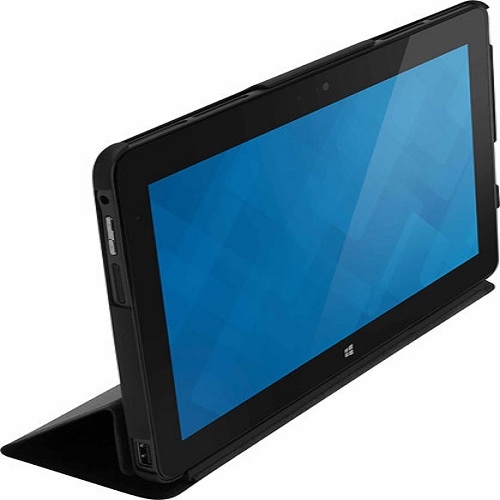
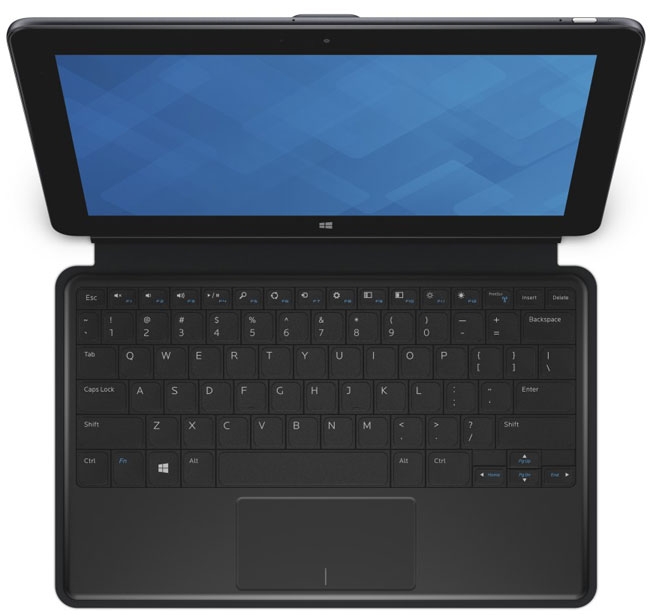
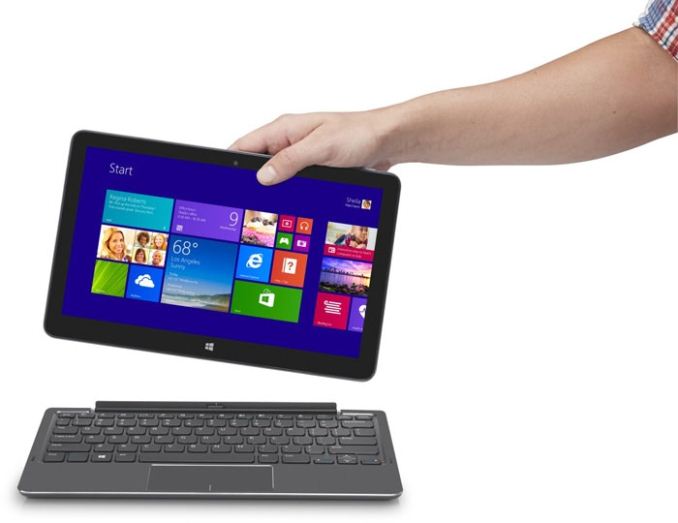
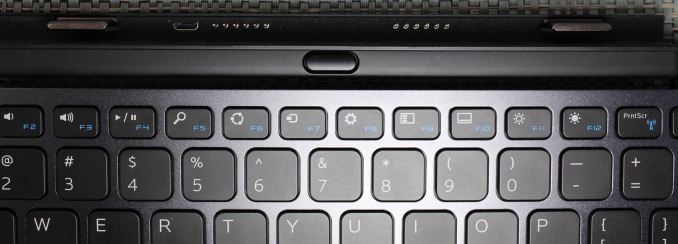

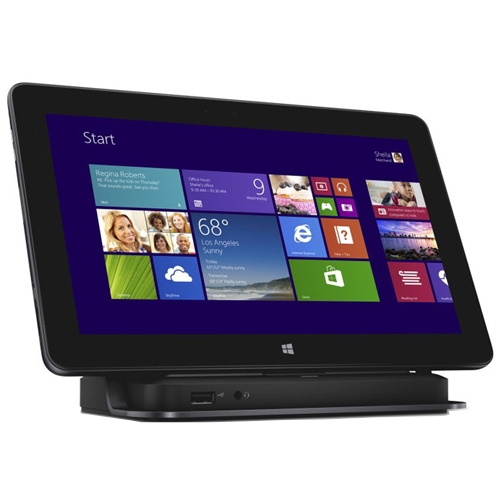








92 Comments
View All Comments
thunng8 - Friday, April 17, 2015 - link
A8X in the iPad Air 2 does ~1820 in single threaded geekbenchTrackSmart - Thursday, April 16, 2015 - link
This seems like an overly strong statement ("horrible!" -- for the price).Core M is a low-power platform. For standard office productivity tasks, it provides similar performance to 15 watt ultrabook processors, but only uses 4.5 watts of power. That's pretty impressive. I don't see where the "horrible" part comes into play. These are meant to be ultramobile parts. The laws of physics dictate that there will be some tradeoff between power consumption and performance when you are constrained by thermal limits and battery capacity.
-If you don't like Core M, choose a product built around a higher TDP platform and move to the other side of the curve (higher power consumption, but also consistently higher performance in continuous workloads).
-If you want a snappy system for standard office productivity tasks in the most mobile form-factor possible, choose a Core M product, and enjoy similar performance to 15 watt parts for "burst" oriented workloads, but in a thinner, lighter, longer-lasting form factor.
-If you want a cheaper price point, choose a slower product built around an Atom processor, which will offer a similar form factor but lower performance.
-And if you can live without Windows, sure, buy an ARM-based tablet.
** It's fantastic that we have these choices today. ** If your problem is the price of Core M, well, unfortunately we are talking about full-on Core architecture processors. Without greater competition, Intel isn't going to give these processors away at Atom prices. And especially not at ARM prices.
As for this particular product, I agree it does't look very "premium" to me, either, that has nothing to do with the Core M processor inside. I'm personally impressed with what Asus did with the UX305 for $699 and a Core M processor. Solid ultra-portable performance in a very thin chassis with long battery life.
Didn't mean to jump on you here. Just sort of surprised that anyone would call Core M itself horrible. Many people have been waiting for this kind of performance in such a low TDP x86 processor.
Qwertilot - Thursday, April 16, 2015 - link
Apple have the resources that they presumably could (more or less) match the CPU single core of this, but I don't think putting so much single core performance into a tablet chip is what you'd chose to do if designing specifically for tablets.Especially with Apple being very keen on having lots and lots of graphics firepower to hand.
CoreM's design makes much more sense if you're going for fanless notebooks, at times with the cooling systems around to run it at somewhat higher power than you'd want for a tablet etc.
Marc GP - Thursday, April 16, 2015 - link
Sorry, but no. Core M doesn't gives you the performance of a 15w ultrabook using only 4.5watts.Because it can only give you that for short bursts before seriously throttling and having to lower its clock from 2,8Ghz (turbo) to its nominal 1Ghz frequency, the only one they can keep for large periods.
Don't try anything that needs steady performance on a Core M, like gaming, for example.
TrackSmart - Thursday, April 16, 2015 - link
I don't mean to be rude, but I don't think you read my post or the article itself very carefully. My post says that for typical office productivity tasks, which are burst-oriented, you get similar performance. I also say that if you want sustained higher performance, you need to move to a higher TDP. The article says similar things and shows benchmarks to demonstrate this. So what exactly are you arguing that I didn't say myself?My Post:
"For standard office productivity tasks, it provides similar performance to 15 watt ultrabook processors, but only uses 4.5 watts of power. ...choose a Core M product, and enjoy similar performance to 15 watt parts for "burst" oriented workloads, but in a thinner, lighter, longer-lasting form factor."
Article: In the PCMark 8 section, which simulates office productivity tasks -- "In these types of workloads, Core M can outperform [15 watt TDP] Haswell-U series parts from the Ultrabooks of last year, which is fairly impressive in a passively cooled device."
To "jjj", you still haven't provided a sensible argument. I'd love it if Intel sold these chips for $50, but it isn't going to happen. You'd have to be living on another planet to think otherwise. Until someone else offers similar x86 CPU performance in a comparable power envelope, these products are going to command prices that are similar to Intel's other Core series processors.
jjj - Thursday, April 16, 2015 - link
It's the worst chip in history!! lolLet me explain why and remember i said horrible for the price.
Die is about 80mm2 so similar to the Exynos 7420 and 50% smaller than a Snapdragon801. Sure it comes on a module so that adds to costs a bit but Intel launched it at some 280$. Even if an OEM would pay 3 times less ,the chip would still cost way way too much. Mobile chips that size sell for 15-30$ depending on how new they are (start at 30 and keep dropping during their lifetime), IHS just a couple of days ago estimated that the Exynos 7420 costs 29.5$ ( to buy not to make).
So Intel here is just abusing it's x86 monopoly and charging absurd prices for the chip. That's why we don't see tabs like this one at 300$ and why the chip is horrible. If it was below 50$ it would be fine but it's a hell of a lot more.
PS: you can check die size and price in one of the early articles on Core M here on AT.
jjj - Thursday, April 16, 2015 - link
Correction- Meant to say that SD801 is 50% bigger or Core M is 33% smaller than SD801 and ended up with something else.smilingcrow - Thursday, April 16, 2015 - link
Translation. It's a great chip but I can't afford it and I'm so very very angry.jjj - Thursday, April 16, 2015 - link
Not even a trace of anger ,i know Intel's ways too well for it's behavior to impress me and i can afford it but i'm not that stupid to buy it (not that i need it to begin with).Anyway , thanks for your valuable contribution to the conversation , it was a true delight.
akdj - Saturday, April 18, 2015 - link
Excellent words 'crow. I'm thinking jjj doesn't understand X86, ARM, and bigLittle architecture NOR how a mobile processor is 'of benefit' to MOST people in today's world. They're as fast as the core i5 power in SB, close to IB and even with thermal limitations, it smokes the Intel iGPU 4000. I'm ambidextrous, using OS X and Windows Android and iOS. To exclaim 'the worst chip in history' considering where Intel was just 18 months ago VERY WELL be the MOST ignorant statement I've seen on Anand's site in some time. Regardless of price (remember, R&D must be recouped to bring the archtiecture's price down), and the magic Apple's done with 64 bit processing over the past two years, it's Qualcomm that's been blindsided. Samsung has switched to their chips, has the A9 contract and have settled disputes everywhere but America. The power of samsung and Apple's engineering prowess and chip trickery (A8x and A8, second and 2.5 gen 64bit chips are nearing a year old, as they start production early summer on the fall iOS releases), it's Intel and Apple/Samsung and TSMC. What the A8/A8x did for the iPad Air 2 is. Itching short of incredible and as an owner for almost nine months, I'm confident there are very few folks in this world that need 'more power' than iPad Air2, Nexus 9, or this Dell reviewed. Most of us that 'work' with a company supplied computer don't really feel like desktops when we get home. Don't have time with the kids and it's easy to throw in the truck and forget about the charger! Laptops are a PITA in comparison and not 'really' that much more capable ESPECIALLY if you use the tools built for and sold I the App Store. Every app of the million plus are optimized at this time for the A5/6 families of SoCs. That's the missing point here. With this Dell, the entire world of software 'Windows built' is now available to you with significantly faster storage and a mature 64bit process from a company that's led the way in silicon for thirty years. And they, like Apple, have the paper to test, retest and 'make it work'. Tegra. Tegra 3, 4 and now these ULV procs taking it to an entirely different level of performanceWith the iGPU it's a matter of efficient cooling in fabless designs to slow down the throttling. That's going to come as they continue the more efficient designs with Skylake and the future.
Just plain ignorance. So sad with all these power packed choices we've got now, their time is limited. Not enough room for a half dozen silicon manufacturers. 2, maybe three will win out and my bets on ARM, Intel and possibly Sammys Exnyos